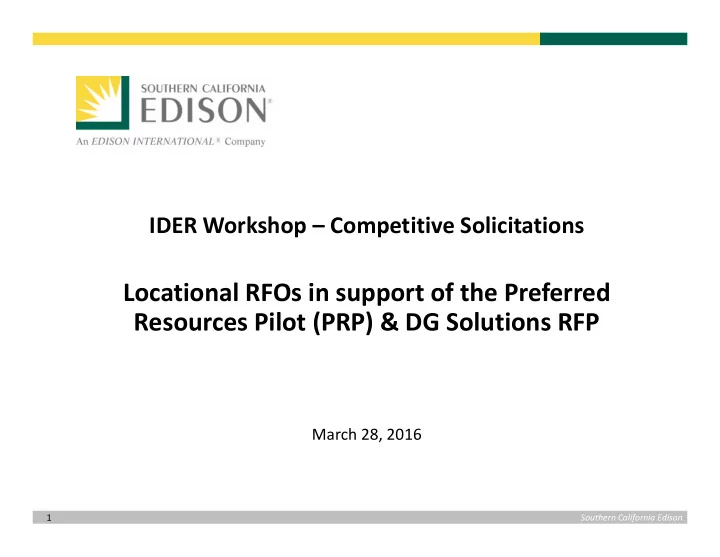

IDER Workshop – Competitive Solicitations Locational RFOs in support of the Preferred Resources Pilot (PRP) & DG Solutions RFP March 28, 2016 1 Southern California Edison
PREFERRED RESOURCES PILOT RFOS 2 Southern California Edison
PRP Background • PRP region is located in the Western LA Basin. The basin is impacted by: Closure of the San Onofre Nuclear Generation Station • Impending closure of ocean cooled power plants • Population and business growth in the PRP region • resulting in an increased peak demand • PRP supports western LA basin reliability needs by: Resolving contingencies associated with resource • deficiencies in the Western LA Basin since resources sited in the southwest part of SCE’s territory are more effective Validating CEC’s and CAISO’s assumptions about preferred • resources ability to achieve energy savings and peak load Distribution Resource Plan reductions Demonstration Informing decision on gas ‐ fired generation in the southwest Region • part of SCE’s territory if some of the Western LA Basin mitigation projects are delayed or fail The PRP objective is to determine if preferred resources (PRs) can deliver what is needed, when needed, and for as long as needed by designing, acquiring, implementing and measuring a diverse portfolio of PRs that can manage the ~300 MW load growth to net zero 3 http://on.sce.com/preferredresources Southern California Edison
PRP Acquisition of Resources Lessons Learned through Acquisition Efforts • PRP’s resource acquisition strategy relies Delivery lead time upon three key acquisition mechanisms*: • varies by resource • DSM programs Ability of • • Existing solicitations programs to deliver varies by • Product ‐ specific targeted solicitations resource type • Development of the resources attributes for Performance • locational RFOs supporting the PRP is driven requirements and penalties may by a portfolio design process increase the • A detailed, location ‐ specific, 365/24/7 load dependability of forecast contracted • Defined resource attributes that may meet the resources forecasted peak demand *Other sources includes utility owned energy storage 4 Southern California Edison
PRP RFO #’s 1 & 2 • PRP RFO 1 • Focused solely on renewable Distributed Generation due to DG specific pipeline concerns • Launched in November 2014, bids received July 2015 • Worked with DG market to identify potential barriers and modified existing pro formas (RAM 5) in an effort to overcome barriers • Targeted 50 MW of in front of the meter DG • Very limited response to RFO • PRP RFO 2 • Launched in September 2015, bids submitted in February 2016 • Expanded eligible products to include DG, DR, ES to build pipeline toward 2022 need • Robust response from market across each individual resource types and combinations of resources • Currently working through short ‐ listing process 5 Southern California Edison
PRP RFO Lessons Learned • Securing large sites in highly urbanized areas is challenging • SCE lowered the project size requirements from 500 kW to 250 kW in order to increase the likelihood of sellers securing sites • In location specific RFOs, a significant number of projects may enter the interconnection queue and potentially impact the results of the interconnection studies • SCE modified the PRP DG RFO requirements associated with interconnection • In subsequent solicitations with similar characteristics SCE may consider de ‐ linking the offer evaluation from the interconnection study process • Once a project is shortlisted, a completed interconnect application would be required to facilitate a more efficient interconnection review process for shortlisted projects 6 Southern California Edison
DG SOLUTIONS RFP 7 Southern California Edison
DG Solutions RFP Background • 2003 CPUC Decision (03.02.068) requiring IOUs to: • Develop a methodology to evaluate and incorporate DG into Distribution System Planning • Provide DG community information through RFPs when viable • Offer DG compensation • Previous Evaluation Methodology • Report produced annually starting in 2003, but no viable projects identified until 2014 • SCE was challenged during 2012 GRC proceeding and reached a Settlement Agreement • Pilot Request For Proposal • Prepared Pro Forma Contracts and other RFP documents • RFP launched during 2012 GRC Cycle (2014) • SCE must report the results of the RFP during the 2012 GRC Cycle (i.e. by the end of 2014) 8 Southern California Edison
DG Solutions RFP Process and Results • Project site selection guidelines: • Customer Type (Commercial/Industrial/Residential) • Minimum Generation Required to defer project 2 years • Sufficient Load Customer Size (Feasibility) in need area • Economic feasibility • DGS cost could not exceed cost of deferred project • DG project cost impacted by automatic load reduction scheme requirement • One site identified as viable, RFP launched for DG solutions in June 2014, bids due August 2014 • No bids submitted to SCE • At same time as RFP, an RFI for alternative solutions was released • SCE did receive responses to RFI for projects that were not exclusively DG 9 Southern California Edison
DG Solutions RFP Lessons Learned • Various regulatory requirements presented problems: • Physical Load Reduction Assurance requirements were a barrier to market participation • Impaired economics of proposal, added equipment cost without payment stream • Created risk for customers to participate • No alternative solutions permitted, limiting market opportunities • In ‐ service date requirement and RFP timeline did not align well • Short payment duration for proposed projects, i.e. only duration of deferral • Limited potential projects to large customers and large generators only • Reduced number of deferral projects and potential customers for market to partner with • Less prescriptive lead to greater response • Multiple parties responded to RFI with package solutions addressing alternatives to prescriptive requirements • Costs not specifically addressed, so unclear if economically viable 10 Southern California Edison
Recommend
More recommend